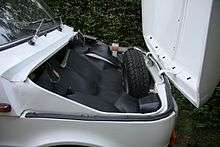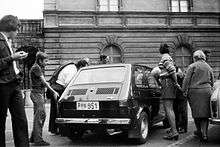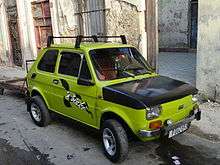Fiat 126
The Fiat 126 (Type 126) is a four passenger, rear-engined city car, introduced by Fiat in October 1972 at the Turin Auto Show[1] as a replacement for the Fiat 500. The majority of 126s were produced in Bielsko-Biała, Poland, as the Polski Fiat 126p, where production continued until 2000. In many markets Fiat stopped sales of the 126 in 1993 in favour of their new front-engined Cinquecento. At a length of 3.05 metres, total production reached almost 4.7 million units. In Poland the car became a cultural icon and earned the nickname Maluch, meaning "The Little One" or "Toddler"[3][4], eventually becoming an official model name in 1997 when it started appearing on the rear of the car.
| Fiat 126 Polski Fiat 126p | |
|---|---|
 | |
| Overview | |
| Manufacturer | Fiat (1972–1980)[1] FSM (Polski Fiat 126p, 1973–1992) Fiat Auto Poland (1992–2000) |
| Also called | Zastava 126 (Yugoslavia) Steyr Puch Fiat 126 (Austria) Fiat 126 Maluch (Poland) FSM Niki (Australia) |
| Production | 1972–2000 4,673,655 units |
| Assembly | Cassino, Italy Termini Imerese, Italy Tychy, Poland (Polski Fiat) Kragujevac, Yugoslavia (Zastava) Steyr, Austria (Steyr Puch) |
| Designer | Sergio Sartorelli |
| Body and chassis | |
| Class | City car (A) |
| Body style | 2-door saloon 3-door hatchback (PF 126 BIS) |
| Layout | RR layout |
| Related | Fiat 133 SEAT 133 |
| Powertrain | |
| Engine | 594 cc Straight-2 652 cc Straight-2 704 cc Straight-2 |
| Dimensions | |
| Wheelbase | 1,840 mm (72.4 in)[2] |
| Length | 3,054 mm (120.2 in)[2] |
| Width | 1,378 mm (54.3 in)[2] |
| Height | 1,302 mm (51.3 in)[2] |
| Curb weight | 580–619 kg (1,279–1,365 lb) |
| Chronology | |
| Predecessor | Fiat 500 |
| Successor | Fiat Panda, Fiat Cinquecento |
History
The 126 shared its wheelbase and much of the same mechanical underpinnings and layout with the Fiat 500, featuring an revised, slightly larger bodyshell designed by Sergio Sartorelli and offering improved safety and interior space. The added interior space resulted from two things: the move of the starter from the top of the engine bellhousing to the side which permitted shifting the bulkhead/rear seat rearward approximately 4 inches (10 cm.) and the lengthening of the roof for rear seat headroom.

Engine capacity was increased from 594 cc to 652 cc at the end of 1977 when the cylinder bore was increased from 73.5 to 77 mm.[5] Claimed power output was unchanged at 23 hp (17 kW), but torque was increased from 39 N⋅m (29 lb⋅ft) to 43 newton metres (32 lb⋅ft).[5] The 594 cc engines were still available in early 1983 production.
A subsequent increase took the engine size to 704 cc in new "restyling" model Fiat 126 Bis (1987–1991), with 26 hp (19 kW) of motive power.
.jpg)
The 126 was manufactured at Fiat's Cassino and Termini Imerese plants, until 1979 — with an overall production of 1,352,912 manufactured in Italy.
The 126 was also manufactured under licence by Zastava in Yugoslavia. In Austria, it was briefly assembled by Steyr Puch as a successor to the successful Puch 500, with assembly lasting until 1975 — and production of 2069 examples.[6] In Greece, there was an attempt to produce a small car named DIM whose technical layout was largely based on the 126, but only ten were produced before the project was abandoned.
The 126 never achieved the popularity of the 500 in Western Europe, as the rear-engined layout lost favour to front-engine, front-wheel drive, nonetheless becoming one of the last and longest-living rear-engine small cars manufactured in Europe, survived only by the VW Beetle whose production lasted until 1978 (2003, globally). The 126 was the last rear-engine small car to be manufactured in Europe until the advent of the Smart Fortwo.
For a brief period in the early 1990s, a German company called POP also offered convertible versions of the 126 BIS. Two models were offered: a lesser equipped one called the "POP 650" and a more luxurious model called the "POP 2000".
Polski Fiat 126p

In Poland, the car was produced under licence by Fabryka Samochodów Małolitrażowych (FSM) (En: Small-Engined Car Factory) in Bielsko-Biała and Tychy under the brand Polski Fiat 126p (literally in English: Polish Fiat 126p) between 1973 and 2000.
Due to a relatively low price it was very popular in Poland and was arguably the most popular Polish car in the 1980s. Its very small size gave it the nickname maluch ("the small one", "small child", pronounced [ˈmalux]). The nickname became so popular that in 1997 it was accepted by the manufacturer as the official name of the car.
.jpg)
At first it was almost identical with the basic model: differences included a higher chassis, a modified grille on the back, and the front indicator lenses that were clear white in Italy but orange in other markets. To distinguish it from the original Italian car, the letter "p" was added to its name.
Throughout the 1980s the 126p was continuously modified. First it received upgraded brakes and new wheels from Italian Fiat, then hazard warning lights were added to meet new lighting requirements.
In 1984, the 126 received a facelift, giving it plastic bumpers (for all versions) and a new dashboard. This model was named the Fiat 126p FL. In 1985 a single rear fog light and reversing light (on opposite sides) were added to the standard plastic bumpers; an electronic ignition system and alternator replaced the undersized generator in around 1987. In 1994, the 126p received another facelift, and some parts from the Fiat Cinquecento; this version was named 126 EL. The 126 ELX introduced a catalytic converter.
In 1987 the 126 BIS went into production, featuring a water-cooled 704 cc engine of Polish construction. However, the original model continued to be produced for the Polish market. BIS used some of parts from Fiat Cinquecento.
The factory battery in 126p had only a 35 Amp-hour capacity, which, combined with undersized generator, resulted in the car never having a fully charged battery unless driven for an extended time. Some owners upgraded to a 45 Amp-hour battery from the Fiat 125p (1.5 Litre engine) to improve the cold start reliability.
The 126p was exported to many Eastern Bloc countries and for several years it was one of the most popular cars in Poland and in Hungary as well. It also found a minor market in Australia between 1989 and 1992, under the name FSM Niki. During that period it was Australia's cheapest car.[7] There was a convertible version developed for the Australian market. It was also successful in Cuba where it was one of the best-selling cars of its time and an estimated 10.000 still exist today.[8]
Throughout the 1980s, there were several experimental prototypes developed in Poland. A cargo version called "Bombel" (literally "bubble", but also a colloquial term for "small child") because of its fibreglass bubble-shaped cargo area; an off-road version propelled by caterpillar tracks and a front wheel drive, front engined model, with a longer front end and a flat cargo area in the rear where the original 126 had its engine. The rear of this prototype was similar to the 126 Bis which also had a rear hatch for accessing a cargo space created by mounting its flat water-cooled engine under the floor.
There was also an attempt at installing a small diesel engine (due to gasoline rationing) in the classic 126p body. It is also a popular platform for electric engine and motorcycle engine swaps.
History of PF 126p
- 1972 – the FSM car factory was built in Bielsko-Biała.
- 6 June 1973 – the first Polski Fiat 126p constructed from Italian parts. The official price was 69,000 Polish złotys with PKO Bank Polski accepting pre-payments on savings books starting 5 February 1973.[9]
- 22 July 1973 – the official opening of the factory's production line (by the end of that year over 1500 Fiats were manufactured).
- September 1975 – production started in a factory in Tychy.
- 1977 – engine capacity increased from 594 cc to 652 cc. Engine power increased to about 24 horsepower (18 kW).
- 1978 – production of types with engine capacity 594 cc ended.
- 1979 – production of Polski Fiat 126p continued only in Bielsko-Biała.
- 1981 – 1,000,000th Polski Fiat 126p produced.
- December 1984 – technical changes in the construction and body. Type FL introduced.
- 1987 – beginning of the production of the water-cooled Polski Fiat 126p Bis version – a three-door hatchback with 704 cc capacity.
- May 1993 – 3,000,000th Polish Fiat 126p produced.
- September 1994 – body improvement, creating type "el" with parts similar to those used in Fiat Cinquecento.
- January 1997 – introduction of a catalytic converter.
- 22 September 2000 – production ended after a production run of 3,318,674 units. All Fiats of the last limited Happy End series were yellow or red (500 cars in red and 500 cars in yellow).
The global production of the car was 4,673,655 units: 1,352,912 in Italy, 2,069 in Austria by Fiat-Steyr and 3,318,674 in Poland.
Political connotations

The PF 126p has special meaning for Poles and its story had a connection with Polish politics during the communist period (Polish People's Republic, up to 1989). During the absolute rule of the PZPR, a private car was considered a luxury item, due to limited availability and low salaries. In 1971 there were only 556,000 passenger cars in Poland.[10] In a top-down planned economy, decisions on whether a state-owned factory could produce a car were taken on political and not just economic grounds. The authorities themselves initially did not find the idea of private cars attractive. The first relatively cheap Polish car was the Syrena, but it was outdated and its production was limited. Limited numbers of cars were also imported from other Eastern Bloc countries. It was difficult to buy a Western car because the Polish złoty, like other currencies in communist states, was not convertible to Western funds and there was no free market in the country.
Thus, the PF 126p was intended to be the first real, popular and affordable car, to provide mobility for ordinary families. The licence was bought after the rise to power of a new PZPR leader, Edward Gierek, who wanted to gain popular favour by increasing consumer spending after the austerity period under Władysław Gomułka. Despite the fact that it was a very small city car, it was the only choice for most families, filling the role of a family car. During holidays, it was common to see families of four driving PF-126s abroad with huge suitcases on a roof rack; sightings of PF-126s towing a small Niewiadów N126 caravan especially designed for the PF 126 were also occasionally reported.[11] PF 126p production, however, was not sufficient and the PF 126p was on sale with a waiting list. Usually families had to wait a couple of years to buy a car.[11] A coupon for a car could also be given by the authorities based on merit.
Nicknames
In Poland it is called Maluch, which literally means "small one" or toddler (and was an official name since 1997),[12] as well as mały Fiat ("small Fiat"), in contrast to Fiat 125p, called duży Fiat ("big Fiat").[13] In some regions, it is also called Kaszlak,[14] literally "cougher" (derived from kaszel, "cough", as its engine's sound resembles a cough when it is started).

In Albania and Kosovo it is known as Kikirez, in Serbian meaning a "little rooster".[15]
In Serbian, Croatian and Bosnian it is known as Peglica (meaning "little iron").[16]
In Slovene the 126 is also called Bolha ("flea"),[17] Piči-poki (loosely translated as "fast-and-loud") or Kalimero on Slovenian coast after a cartoon character Calimero.[18]
In Hungarian, it is known as kispolszki ("Little Polish", while the 125p is the nagypolszki, meaning "Big Polish"), kispolák ("Little Pole") or kispók ("Little spider"); also, the car was nicknamed egérkamion, meaning "a mouse's truck".[19]
In Germany the Fiat 126 was known as the Bambino, the Italian word for child.[20]
In Cuba it is known as the "Polqi" or "Polaquito", meaning "Little Pole" or "Little Polish man", and in Chile as "Bototo".[21][22]
References
- "Fiat 126 Key Dates Time Line - illustrating the life of the original Fiat 126 from 72', the Fiat 126 de ville and the Fiat 126 BIS". fiat126.co.uk. Retrieved 9 May 2009.
- "1973 Fiat 126 Technical specifications". carfolio.com. Retrieved 25 February 2010.
- Metro.co.uk, Hannah Lawrence for (18 February 2017). "Residents in Polish city save up and buy Tom Hanks a vintage car". Retrieved 12 July 2017.
- "Polish fans buy Tom Hanks iconic 'toddler' car". 31 January 2017. Retrieved 12 July 2017 – via Reuters.
- Simoneit, Ferdinand, ed. (23 November 1977). "Mehr Hubraum und Drehmoment fuer den Fiat 126". Auto, Motor und Sport. 24: 20.
- "STEYR-PUCH-FREUNDE OBERKÄRNTEN". www.steyrpuch.at. Retrieved 19 December 2018.
- "FSM Niki 650, too little, too late". Transeum. Retrieved 29 August 2011.
- Welle (www.dw.com), Deutsche. "Polish Fiat 126p sees unlikely Cuban revival | DW | 11 August 2016". DW.COM. Retrieved 19 December 2018.
- Włodarz, Adam (18 December 2006). "Polski Fiat 126p - Przez książeczkę do Fiata" (in Polish). Auto Swiat. Archived from the original on 25 April 2012. Retrieved 5 November 2011.
- Zaremba, Marcin (2004). "Good bye, Gierek!". Polityka (in Polish). 45 (2477): 79.
- Zakrzewski, Adam (2010). pp.72-83
- Turnock, David (1997). The East European economy in context: communism and transition. Taylor & Francis. p. 307. ISBN 978-0-415-08626-4. Retrieved 6 November 2010.
- Swan, Oscar E. (1986). Intermediate Polish. Slavica Publishers. p. 71. ISBN 978-0-89357-165-8. Retrieved 6 November 2010.
- Czeszewski, Maciej (2006). Słownik polszczyzny potocznej (in Polish). Wydawn. Naukowe PWN. p. 129. ISBN 978-83-01-14631-3. Retrieved 6 November 2010.
- "Fiat 126p "Maluch" • Skarbnica wiedzy • AutoCentrum.pl". www.autocentrum.pl. Retrieved 12 July 2017.
- Labourdette, Jean-Paul, Dominique Auzias (2007). Przewodnik Chorwacja (in Polish). Petit Fute. p. 222. ISBN 978-83-60496-20-6. Retrieved 6 November 2010.
- Weiss, Peter (1998). Slovar govorov Zadrečke doline med Gornjim gradom in Nazarjami. Znanstvenoraziskovalni center SAZU. p. 206. ISBN 978-961-6182-47-8. Retrieved 6 November 2010.
- "Fiat 126". Bohemia Interactive Forums. Retrieved 12 July 2017.
- "Igazi gyöngyszem – Lánctalpas kispolák". 18 March 2015. Retrieved 12 July 2017.
- Deiss, Richard (2010). Silberling und Bügeleisen - 1000 Spitznamen in Transport und Verkehr und was dahinter steckt (in German). Ausstattung/Bilder. p. 50. ISBN 978-3-8391-6269-9. Retrieved 6 November 2010.
- Ciastek, P. (7 September 2016). "Fiat 126p podbił Kubę... nazywają go "polaquito"". Retrieved 12 July 2017.
- Semczuk, Przemysław (1 October 2014). "Maluch. Biografia". Otwarte. Retrieved 12 July 2017 – via Google Books.
Bibliography
- Klimecki, Zbigniew; Podolak, Roman (1982). Polski FIAT 126P: technika jazdy, obsługa i usprawnienia (in Polish). Wydawnictwa Komunikacji i Łączności. ISBN 978-83-206-0092-6.
- Sowa, Aleksander (2008). Fiat 126p Mały Wielki Samochód (in Polish). Złot Myśli. ISBN 978-83-7582-550-3.
- Zakrzewski, Adam (2010) (in Polish). Auto-moto PRL: władcy dróg i poboczy, Demart, Warsaw, ISBN 978-83-7427-484-5